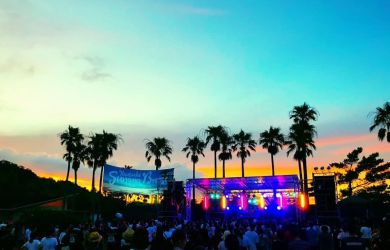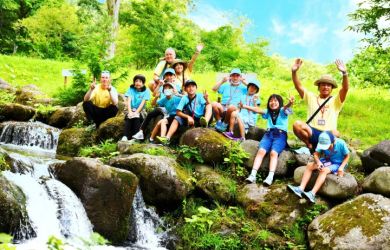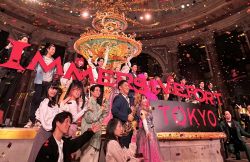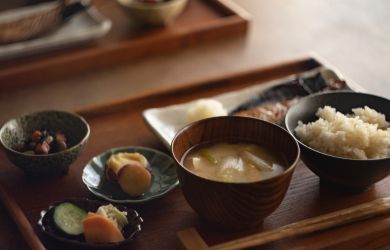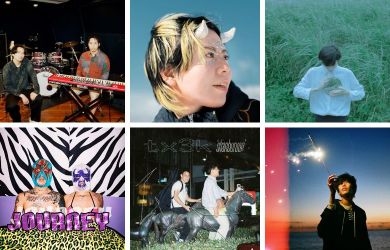
March 27, 2009
On the Olympic Trail
Discover the legacy of the 1964 Tokyo Games as the city gears up for the next one… maybe
By Metropolis
Originally published on metropolis.co.jp on March 2009

Photo by Alena Eckelmann
On October 10, 1964, Tokyo held its breath as Yoshinori Sakai, a 19-year-old runner born in Hiroshima an hour and a half after the atomic bomb was dropped, took to the podium in the city’s National Stadium to light the Olympic flame. It was a cathartic moment, marking the end of a long and gruelling process of postwar reconstruction. With the opening of the 1964 Games, Japan stepped back onto the international stage, and in the process became the first Asian country ever to host the event.
Come October 2, Tokyo will find out whether it will have a chance to do it all again, as the IOC announces which city will host the 2016 Games. (At the time of writing, the odds are looking pretty favorable for the Big T.) It’s as good a time as any to put your sneakers on, hit the Olympic trail and see what Japan had to offer the world’s top athletes half a century ago.
Tokyo National Stadium in Meiji Shrine Outer Park was at the heart of the action in 1964, hosting the opening and closing ceremonies as well as the track-and-field competitions. With a capacity of over 57,000, it remains one of the largest stadiums in Japan and is the venue for the finals of the country’s two biggest soccer competitions: the Emperor’s Cup and the J. League Cup. If you’re not a footie fan, come here for a run or bicycle ride on weekends, when the tree-lined streets around the stadium are closed to traffic. Alternatively, visit the Prince Chichibu Memorial Sports Museum inside the stadium, which houses an extensive collection of memorabilia and displays covering the history of the Games.
10-2 Kasumigaoka-machi, Shinjuku-ku. Museum open daily 9:30am-4:30pm, except second and fourth Tue. ¥300. Nearest stn: Sendagaya or Kokuritsu-Kyogijo.
The Nippon Budokan (Japan Martial Arts Hall) in Kudanshita was built specifically for the judo competition in the 1964 Games—the first time that the sport had been included in the Olympics. Its eye-catching octagonal structure and the onion-shaped sculpture on the roof were modelled after the Yumedono (Hall of Dreams) at Nara’s Horyu Temple. The venue can hold over 14,000 people, and continues to host annual martial arts competitions and pro wrestling matches. However, it’s become synonymous with rock concerts, a trend that started when The Beatles controversially appeared there in 1966. If you’re not going for a particular event, take a walk through the nearby Kitanomaru Park and admire the architecture from afar.
2-3 Kitanomarukoen, Chiyoda-ku. Nearest stn: Kudanshita.
Yoyogi National Gymnasium hosted the swimming and diving competitions in 1964, and its 50-meter pool is now open to the public. The building’s innovative suspension-roof design, widely praised at the time, was created by renowned Tokyo architect Kenzo Tange, who also designed the Tokyo Metropolitan Government Building in Shinjuku. Its two halls can hold over 10,000 people and are frequently used for sports tournaments and large-scale concerts. Stroll along the spacious elevated walkway between the Shibuya and Harajuku entrances for an excellent view of the building—and the pleasant sensation of floating above the crowds that plague this part of town.
2-1 Jinnan, Shibuya-ku. Nearest stn: Harajuku.

Photo by Alena Eckelmann
Komazawa Olympic Park in Setagaya is another purpose-built complex that has enjoyed continued popularity since 1964. It’s home to the Olympic Tower, an imposing concrete structure that served as the control center during the Games and resembles nothing so much as an enormous game of Jenga. Nearby, the 22,000-capacity Komazawa Stadium hosted the wrestling, hockey and volleyball competitions, and is now used for soccer matches. For a true blast from the past, seek out the Tokyo Olympic Memorial Gallery, a small museum containing displays of memorabilia including posters, medals and the Olympic torch, as well as information about the participating countries, competitions and medallists back in ’64.
1-1 Komazawa-koen, Setagaya-ku. Museum open daily 9:30am-5pm, except first and third Mon. Admission: free. Nearest stn: Komazawa-Daigaku (Denentoshi line).
